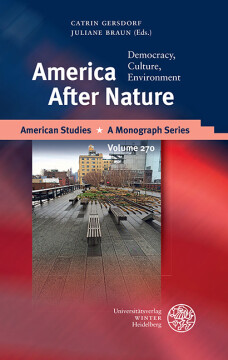
BUCH
America After Nature
Democracy, Culture, Environment
Herausgeber: Gersdorf, Catrin | Braun, Juliane
American Studies – A Monograph Series, Bd. 270
2016
Zusätzliche Informationen
Bibliografische Daten
Abstract
In ‘Democratic Vistas’, a text that responds to the United States’s devastating experiences of the Civil War, Walt Whitman reminds his readers that the nation should continue to find its political ideals and cultural purposes in “the Laws of Nature and of Nature’s God.” His concept of nature was anchored in the ideas of eighteenth-century natural rights philosophy, but also in Ralph Waldo Emerson’s definition of nature “in the common sense” as a totality of essences unaltered by human labor and industry. Whitman’s contention that nature provides the concepts and ideas at the core of America’s political, cultural, and social structure, and the current critical contention that nature's massive restructuring will not remain without consequences for modern culture(s), offer the conceptual and historical frame for the essays collected in this volume. They all investigate the social, political, ethical and aesthetic questions and controversies that are raised in the study of America in a so-called postnatural world.
Inhaltsverzeichnis
| Zwischenüberschrift | Seite | Aktion | Preis |
|---|---|---|---|
| Cover | C | ||
| Title Page | 3 | ||
| Copyright | 4 | ||
| Table of Contents | 7 | ||
| Introduction | 11 | ||
| Catrin GERSDORF & Juliane BRAUN, Democracy after Nature: National Legacies, Global Futures | 13 | ||
| Keynotes | 27 | ||
| Frank ZELKO, Natural Wonders: Ecological Enchantment in a Secular Age | 29 | ||
| John M. MEYER, Denialism versus the Resonance Dilemma in the US | 65 | ||
| Julie SZE, Environmental Justice and Environmental Humanities in the Anthropocene | 83 | ||
| Sylvia MAYER, Risk Narratives: Climate Change, the American Novel, and the World Risk Society | 97 | ||
| The Politics of Nature | 119 | ||
| Sascha PÖHLMANN, Walt Whitman’s Politics of Nature and the Poetic Performance of the Future in “Crossing Brooklyn Ferry" | 121 | ||
| Michelle MART, Pesticides and the Transformation of the National Audubon Society | 143 | ||
| Gesa MACKENTHUN, Bisoncide and Neo-Savagism: The Myth of the Unecological Indian | 163 | ||
| Laurenz VOLKMANN, Transcultural Learning and Ecodidactics: New Trends in Teaching English as a Foreign Language | 199 | ||
| Ecology and Urban Environments | 219 | ||
| Boris VORMANN, Beneath and Beyond the Sustainable City | 221 | ||
| Emmanuel Tristan KUGLAND, Artistic Negotiations of the Right to the City: Graffiti Artists and the ‘Ghosts’ of Manhattan in Brian Wood’s "DMZ" | 243 | ||
| Frank MEHRING, Visualizing and Sounding the “Walden State of Mind:” The Urban Matrix in Henry David Thoreau’s Environmental Imagination | 259 | ||
| Nassim Winnie BALESTRINI, Hip-Hop Life Writing and African American Urban Ecology | 287 | ||
| Visualizing Nature | 309 | ||
| Heike SCHÄFER, Nature, Media Culture, and the Transcendentalist Quest for the Real | 311 | ||
| J. Jesse RAMÍREZ, Green Futures; or, How to Enjoy Eco-Apocalypse | 331 | ||
| Antonia PURK, A Photo Album of History: Ekphrasis in Jamaica Kincaid’s "My Garden (Book)": | 349 | ||
| Ingrid GESSNER, “We see the surface, but there is something beyond the surface”: Recovering Masumi Hayashi’s EPA Superfund Site Photo Collages | 369 | ||
| Risk, Posthumanism, and Digital Cultures | 389 | ||
| Michaela CASTELLANOS, "Star Trek IV" and Environmental Risk: Balancing on Irony’s Edge | 391 | ||
| Wojciech MALECKI, From Speculative Darwinism to Interspecies Narratives: The Consequences of Pragmatism for the Posthumanities | 405 | ||
| James DORSON, Critical Posthumanism in the Posthuman Economy: The Case of “Mister Squishy” | 423 | ||
| Babette B. TISCHLEDER, Earth According to Pixar: Picturing Obsolescence in the Age of Digital (Re)Animation | 441 | ||
| Maryann SNYDER-KÖRBER, Flarf: E-Detritus Composition and the Analytical Affordances of a Late Avant-Garde | 461 | ||
| Contributors | 483 | ||
| Back cover | Back C |


 Publishing Platform by CloudPublish
Publishing Platform by CloudPublish